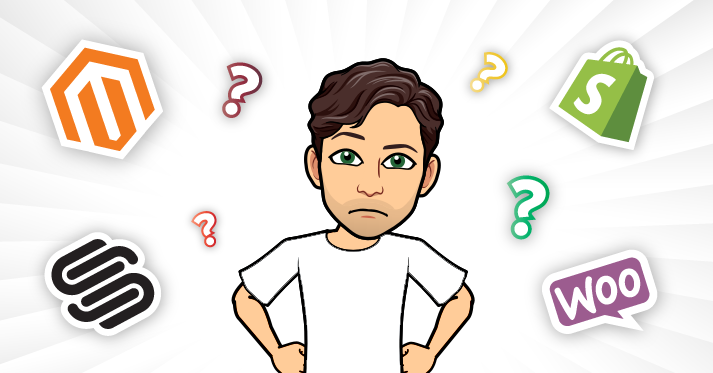Shopify, Magento, WooCommerce, BigCommerce, Squarespace, Oh My, What’s The Best Selling Platform For You?

So you’re looking for an online selling platform and wondering which is the best for you? I spoke with two experts in the field about five of the most popular platforms.
Squarespace
Let’s just get this out of the way. Squarespace has an add-on for eCommerce, but unlike some of the other platforms we’ll be discussing, it wasn’t built for eCommerce. Squarespace has great design features for websites, and if you have a website with Squarespace already and want to dabble in selling products then fine go for it, but it isn’t scalable for larger operations, says expert #1. He had to dig around forums to find information about basic SEO functions. Squarespace is popular in the U.S. for web design, but if you look at what platforms businesses are using foreCommerce, not many will be using it. It’s simple and easy for your portfolio site, but not recommended for selling products.
Shopify
Shopify is very well-known. It’s easy enough to use if you aren’t tech-savvy and don’t want to hire a web developer. In fact, you don’t even need to purchase external web hosting or url – all of the technical parts are already taken care of for you in the Shopify’s plan. In case you do need help with anything beyond that, they have good support available. In terms of payment solutions, you have options of PayPal and the like, but you can also use Shopify’s internal payment processing method and they will waive any transaction fees and discount the payment processing – depending on the plan you choose. Note that there are products that Shopify Payments will not support the sale – and the transaction won’t work.
The downside to Shopify, as explained by expert #1, is that there are limits when it comes to customization. On Shopify, you pick a theme and the shop functions and business runs smoothly. But the minute you need customization, you’ll need to hire developers to come in and do that for you. Shopify doesn’t have customizing options just out for you and so companies often outgrow Shopify.
For this reason, Shopify is looking to appeal to larger companies, with Shopify Plus, especially as they’ve been known mostly for being better for small business. Expert #1 said that most businesses tend to just stay with Shopify and if they outgrow it, they’ll likely move on to another platform. This is probably because the Shopify software is not ready to leave the market that they’ve cornered. My advice would be to consider Shopify if you’re just starting out, don’t want to hire anyone, and just need something functional for now.
WooCommerce
WooCommerce is perhaps a step up from both Shopify and Squarespace in terms of technology. It’s a WordPress plug-in, so similar to Squarespace in that if you already have a website with WordPress and are savvy with how to use it, then this is a good option for you. It’s even better because WordPress is a huge community of people helping each other and so is a great place to scale. Again though, WordPress can be difficult to navigate and so if you are a technological novice and don’t know WordPress at all, it may be best to start elsewhere. Of course the company is aware of this though, especially with the drag and drop options everywhere – thank you Squarespace – and so the release of their Gutenberg update should make the software a little easier to use. There will be a learning curve with any product you use so if for some reason you’ve had your eye on WooCommerce, don’t let this discourage you against it too much.
Because I mentioned it with Shopify, I will say that WooCommerce (and all of the other platforms really) has all of the options for payment gateways. There will be a fee with all credit card processing on all platforms, so you need to be aware of what your transaction fees are, along with how they compare to the profit you make from your products. If you’re not making much, 2.5 percent is a huge cut, but it isn’t if you’re making a thousand on an individual sale.
BigCommerce
BigCommerce was founded in 2009 but is regarded by some as up and coming. Expert #1 didn’t have much experience with it yet except noticing some people he knows moving to it from Magento. It costs $250 a month for their Pro plan, which is less than Shopify’s top plan. For their Enterprise plan – all that BigCommerce has to give – you have to contact them for “custom pricing lower than Magento and Shopify Plus.” It boasts hosting clients like Ben & Jerry’s and Camelbak. It also partners with WordPress for web design, so likely has room for some customization.
Magento
I saved Magento for last because it’s a“monster” as expert #1 calls it. Magento hosts companies such as Zumiez, Nestle, and Helly Hansen, with good reason. You absolutely need web developers to build it for you, because you can build an entirely custom store – which for these companies costs a pretty penny. I spoke with a web developer who founded Creating Digital, LLC., and he says their prices range from $50,000 to $120,000 and the development can take anywhere from three months to a year. He also said that the clients he has that use Magento typically have 50 to 100 products they’re selling. Magento is for enterprise-level companies, so $100K for them won’t make a dent. Plus it’s an investment in your business that pays off. This isn’t recommended for small companies just starting out, unless you’ve got enough funding and need this level of customization. Even then, it’s probably better to start on Shopify -or maybe BigCommerce – and then get an agency to develop your Magento site down the line. If you are going for Magento, then you must be cautious of that old saying that too much of a good thing can be bad. Because this product has so much customization, you have to hire the correct developers that are familiar with Magento, so that your specific site can sustain through any updates that Magento does. P.S. just like how Shopify is trying to move beyond the bounds of its well known and successful market, Magento wants to stay in their market -bad. Their most recent version update upped prices instead of lowering them.
Good luck out there and remember that you need to pick the best selling platform for your business to meet your needs.


